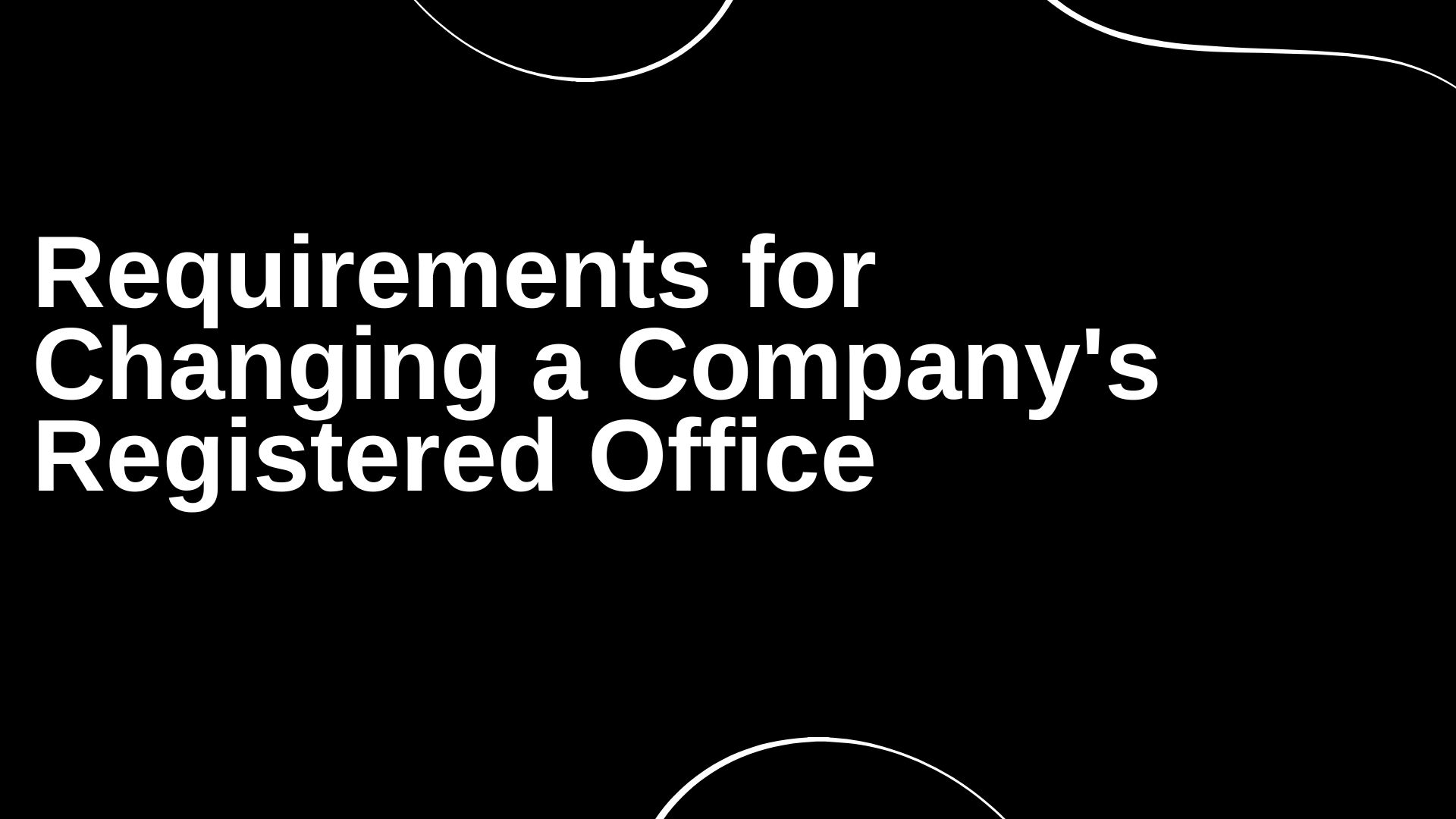Guidelines for Changing a Company’s Registered Office
According to the Companies Act, 2013, every company must establish a registered office within thirty days of its incorporation. This office must be maintained throughout the company’s existence and is specified in the Memorandum of Association (MOA) and Articles of Association (AOA).
The registered office is where the company receives official communications and notices. It serves as the company’s primary business location, and its address must be provided to the Registrar of Companies (ROC).
If a company needs to change its registered office, it must adhere to the procedures outlined in the Act and the Companies (Incorporation) Rules, 2014. Below are the compliance requirements for different scenarios:
Changing Office Within the Same City
To change the registered office within the same city, village, or town limits, the company must:
Hold a Board meeting and pass a Board resolution approving the change.
File Form INC-22 with the ROC within fifteen days of the resolution.
Documents to attach with Form INC-22 include:
No Objection Certificate (NOC) from the owner if the office is on leased/rented land.
Rent/Lease agreement, if applicable.
A utility bill showing the office address, dated within the last two months.
Changing Office Outside the City but Within the Same ROC Jurisdiction
To change the registered office outside the local limits of the current city or town but within the same ROC jurisdiction, the company must:
Conduct a Board meeting to pass a resolution calling for an Extraordinary General Meeting (EGM).
Pass a Special Resolution in the EGM to approve the office change.
File Forms INC-22 and MGT-14 with the ROC within 30 days of passing the Special Resolution.
Documents to attach with Forms INC-22 and MGT-14 include:
A copy of the Special Resolution.
NOC from the property owner if the office is on leased/rented land.
Rent/Lease agreement, if applicable.
A utility bill showing the office address, dated within the last two months. Also, check out DIN ROC Filing & LLP ROC Filing services.
Compliance Requirements for Changing a Registered Office Outside City Limits and Between Different ROC Jurisdictions
When a company decides to shift its registered office beyond the local limits of the current city or town and into the jurisdiction of a different Registrar of Companies (ROC) within the same state, it must adhere to the following compliance steps:
Board Meeting and Resolution:
Convene a Board meeting to approve the decision and pass a resolution to call an Extraordinary General Meeting (EGM).
Special Resolution in EGM:
During the EGM, secure approval for the change in the registered office by passing a Special Resolution.
Filing Form MGT-14:
Submit Form MGT-14 to the ROC within 30 days of passing the Special Resolution.
Application for Approval (Form INC-23):
File Form INC-23 with the Regional Director to obtain approval for moving the office between ROC jurisdictions.
Notification Requirements Before Filing:
At least one month prior to submitting the application to the Regional Director:
Publish notices in an English daily and a local-language newspaper of the district where the current registered office is located.
Notify depositors, debenture holders, and creditors individually, indicating their right to raise objections to the Regional Director within 21 days of notice publication if their interests are affected.
Confirmation from Regional Director:
If no objections are raised, the Regional Director will issue a confirmation within 30 days of receiving the application.
Filing Confirmation with ROC:
Submit the Regional Director’s approval to the ROC using Form INC-22 within 60 days of receiving confirmation.
Documents Required for Form INC-23:
Certified copy of the Board resolution for office relocation.
Special Resolution passed in the EGM.
Declaration by two directors or key managerial personnel affirming no dues to employees and creditor consent.
Acknowledgment of intimation to the state’s Chief Secretary confirming employee interests remain unaffected.
Compliance Requirements for Changing a Registered Office Across States
When relocating a registered office from one state to another, the following steps must be followed:
Board Meeting and Resolution:
Convene a Board meeting to call an EGM and propose altering the Memorandum of Association (MOA).
Special Resolution in EGM:
Pass a Special Resolution during the EGM to authorize the state change and modify the MOA.
Filing Form MGT-14:
Submit Form MGT-14 to the ROC within 30 days of passing the Special Resolution.
Application for Approval (Form INC-23):
File Form INC-23 with the Regional Director to obtain Central Government approval for the relocation.
Notification Requirements Before Filing:
One month before submitting the application to the Regional Director:
Publish notices in both an English daily and a local-language newspaper where the current office is located.
Notify depositors, debenture holders, and creditors about the proposed MOA alteration, allowing them to file objections within 21 days if their interests are affected.
Approval from Central Government:
If no objections are raised, the Central Government will process the application within 60 days.
Filing Approval with ROC:
Submit the Regional Director’s approval to the ROC using Form INC-22 within 60 days of receiving approval.
File Form INC-28 with the ROCs of both the current and new states to formalize the change.
Documents Required for Form INC-23:
Copy of the MOA reflecting the proposed changes.
Certified minutes of the EGM authorizing the MOA alteration.
Board resolution or Power of Attorney/Vakalatnama for the application.
List of creditors and debenture holders with their claims, debts, or liabilities.
Declaration by two directors and the Company Secretary confirming the completeness of the creditors’ list and stating no additional liabilities.
Declaration confirming no retrenchment of employees due to the relocation.
These compliance steps ensure a smooth transition for the registered office, whether within the same state or across state lines.
Compliances After ROC Approval for Change in Registered Office
Once the Registrar of Companies (ROC) approves the change in a company’s registered office, the following compliances must be undertaken:
Public Notification:
Publish a general notice in a newspaper to inform members and stakeholders about the change in the registered office address.
Update MOA and Office Signage:
Update the company’s Memorandum of Association (MOA) to reflect the new address.
Display the updated registered office address prominently at all offices, buildings, or locations where the company operates. Ensure the signage is legible and placed in a conspicuous position.
Revise Official Stationery:
Replace the old address on all official stationery, including letterheads, invoices, billheads, receipts, and other publications, with the updated registered office address.
Notify Banks and Financial Institutions:
Inform all banks and financial institutions where the company holds accounts about the change in address.
Update Tax Records:
File applications with the Income Tax Authority to update the company’s address in TAN and PAN records.
Utility Services:
Notify utility service providers, such as electricity, telephone, and internet companies, about the new address.
Government Authorities:
Update the address with relevant government departments, including Customs, Central Excise, Service Tax, and Sales Tax Authorities, to ensure compliance.
Need Help?
FAQs
1. What is the penalty for non-compliance with registered office provisions under the Companies Act?
Failure to comply with registered office provisions can result in penalties. The company and responsible individuals are liable to pay ₹1,000 per day for each day of default, up to a maximum of ₹1 lakh.
2. Under what circumstances can a company change its registered office?
The decision to change a registered office depends on the board of directors and stakeholders. Common reasons include:
- Expansion requiring larger office space.
- The lease on the current premises has expired or is being terminated.
- Strategic relocation to explore new markets or business opportunities.
- A shift necessitated by investments or mergers with other companies.
3. Is a registered office the same as a head office?
While the registered office is the principal location for legal correspondence and official records, a head office refers to the main operational hub of a business. These can be the same or different locations based on the company’s structure and needs.
4. Can a registered office be changed to a residential address?
Yes, a registered office can be relocated to a residential address, as there is no restriction against this under the Companies Act.
5. Can a company change its registered office immediately after incorporation?
Yes, the registered office can be changed at any time post-incorporation, provided the company follows the necessary procedures and compliances as prescribed under the Companies Act.
Table of Contents
Toggle



